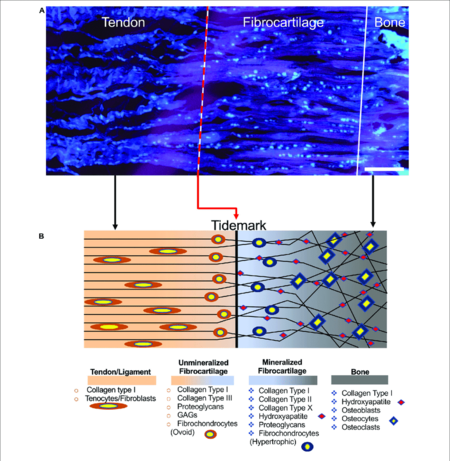Enthesis: Difference between revisions
No edit summary |
No edit summary |
||
| Line 1: | Line 1: | ||
{{stub}} | {{stub}} | ||
The enthesis is the interface between tendon/ligament and bone. See also about the [[Myotendinous Junction|myotendinous junction]], the connection between muscle and tendon. | The enthesis (plural entheses) is the interface between tendon/ligament and bone. See also about the [[Myotendinous Junction|myotendinous junction]], the connection between muscle and tendon. | ||
==Structure and Function== | ==Structure and Function== | ||
| Line 14: | Line 14: | ||
'''Fibrocartilaginous Enthesis''' | '''Fibrocartilaginous Enthesis''' | ||
The fibrocartilaginous enthesis consists of a progressive mineralisation gradient that is organised into four zones. The boundary between the unmineralised and mineralised fibrocartilage zones is called the tidemark. The thickness of the junction is around 500 µm. | The fibrocartilaginous enthesis consists of a progressive mineralisation gradient that is organised into four zones. The boundary between the unmineralised and mineralised fibrocartilage zones is called the tidemark where there is an abrupt transition. The thickness of the junction is around 500 µm. | ||
# Tendon/ligament | # Tendon/ligament: longitudinally oriented fibroblasts and a parallel arrangement of collagen fibres. | ||
# Unmineralised fibrocartilage: contains various collagens (types I, II, III, X, IX) and proteoglycans (mostly aggrecans with associated chondroitin 4- and 6- glycosaminoglycans). The collagen fibres become increasingly randomly arranged. Fibroblasts and tenocytes are replaced by ovoid-shaped aligned fibrochondrocytes. | # Unmineralised fibrocartilage: contains various collagens (types I, II, III, X, IX) and proteoglycans (mostly aggrecans with associated chondroitin 4- and 6- glycosaminoglycans). The collagen fibres become increasingly randomly arranged. Fibroblasts and tenocytes are replaced by ovoid-shaped aligned fibrochondrocytes. | ||
# Mineralised fibrocartilage. There are hypertrophic chondrocytes surrounded by type II and X collagens and aggrecans. | # Mineralised fibrocartilage. There are hypertrophic chondrocytes surrounded by type II and X collagens and aggrecans. | ||
| Line 21: | Line 21: | ||
==Clinical Applications== | ==Clinical Applications== | ||
A disease process affecting the entheses is called enthesopathy or enthesitis. | |||
Common locations for injury are the rotator cuff, the anterior cruciate ligament, the Achilles tendon, the medial collateral ligament of the knee, tennis elbow, and jumper's knee. | Common locations for injury are the rotator cuff, the anterior cruciate ligament, the Achilles tendon, the medial collateral ligament of the knee, tennis elbow, and jumper's knee. | ||
Enthesopathy is also associated with spondyloarthropathies. | |||
== References == | == References == | ||
[[Category:Anatomy]] | [[Category:Anatomy]] | ||
Revision as of 19:03, 9 August 2021
The enthesis (plural entheses) is the interface between tendon/ligament and bone. See also about the myotendinous junction, the connection between muscle and tendon.
Structure and Function

The structure of the enthesis varies widely depending on the location. There are two main categories of entheses: the indirect fibrous enthesis, and the direct fibrocartilaginous enthesis.
The function of the enthesis is to dissipate stress away from the interface.
Fibrous Enthesis
The fibrous enthesis consists of tendons and ligaments being connected through acute angles to bones with collagen fibres extending directly from the periosteum, termed Sharpey's fibres.
Fibrocartilaginous Enthesis
The fibrocartilaginous enthesis consists of a progressive mineralisation gradient that is organised into four zones. The boundary between the unmineralised and mineralised fibrocartilage zones is called the tidemark where there is an abrupt transition. The thickness of the junction is around 500 µm.
- Tendon/ligament: longitudinally oriented fibroblasts and a parallel arrangement of collagen fibres.
- Unmineralised fibrocartilage: contains various collagens (types I, II, III, X, IX) and proteoglycans (mostly aggrecans with associated chondroitin 4- and 6- glycosaminoglycans). The collagen fibres become increasingly randomly arranged. Fibroblasts and tenocytes are replaced by ovoid-shaped aligned fibrochondrocytes.
- Mineralised fibrocartilage. There are hypertrophic chondrocytes surrounded by type II and X collagens and aggrecans.
- Bone
Clinical Applications
A disease process affecting the entheses is called enthesopathy or enthesitis.
Common locations for injury are the rotator cuff, the anterior cruciate ligament, the Achilles tendon, the medial collateral ligament of the knee, tennis elbow, and jumper's knee.
Enthesopathy is also associated with spondyloarthropathies.
References
- ↑ Sensini, Alberto et al. “Tissue Engineering for the Insertions of Tendons and Ligaments: An Overview of Electrospun Biomaterials and Structures.” Frontiers in bioengineering and biotechnology vol. 9 645544. 2 Mar. 2021, doi:10.3389/fbioe.2021.645544

